Active Dielectric Window: A New Concept of Combined Acoustic Emission and Electromagnetic Partial Discharge Detector for Power Transformers
Abstract
:1. Introduction
2. General Conceptual Assumptions of the Active Dielectric Window for PD Online Monitoring and Location
3. Designing and Modeling of Active Dielectric Window Components
3.1. Mathematical Modeling of Piezoelectric Transducer Structures
3.2. Matching and Backing Layers
3.3. Piezoelectric Element
3.4. Frequency Response Modeling of the Piezoelectric Transducer
- The first resonance frequency should be similar to the PAC R15D sensor, approximately 150 kHz;
- The bandwidth should range between ~100 and ~300 kHz, with a central frequency of ~200 kHz;
- The frequency response curve in the working frequency range ought to be possibly the flattest;
- To improve the efficiency of energy transmission of the acoustic signal from the oil to the piezoelectric element, the acoustic impedance of the matching layer should total 6.3 MRayl;
- Because it was earlier assumed that the standard window made of ceramics would have a thickness of 20 mm, then therefore the height of the piezoelectric element should not exceed 15 mm (the remaining space was intended for matching and backing layers).
4. Fabrication of a Prototype Active Dielectric Window
4.1. Dielectric Window
4.2. Ultrasonic Transducers
4.3. AE Signal Conditioning Unit
4.4. UHF Antenna
5. Laboratory Tests of the Prototype Active Dielectric Window
5.1. Sensitivity of Detection of AE Waves Generated by PD
5.2. Test of the PD Source Location Using the Active Dielectric Window and TDOA technique
6. Conclusions
Funding
Conflicts of Interest
References
- Sikorski, W.; Ziomek, W. Detection, Recognition and Location of Partial Discharge Sources Using Acoustic Emission Method. In Acoustic Emission; Sikorski, W., Ed.; IntechOpen: Rijeka, Croatia, 2012; pp. 49–74. ISBN 978-953-51-0056-0. [Google Scholar]
- IEEE Guide for the Detection and Location of Acoustic Emissions from Partial Discharges in Oil-Immersed Power Transformers and Reactors. In IEEE Std C57.127-2007 (Revision of IEEE Std C57.127-2000); IEEE: Piscataway, NJ, USA, 2007. [CrossRef]
- Lundgaard, L.E. Partial discharge. XIII. Acoustic partial discharge detection-fundamental considerations. IEEE Electr. Insul. Mag. 1992, 8, 25–31. [Google Scholar] [CrossRef]
- Bengtsson, T.; Leijon, M.; Ming, L. Acoustic Frequencies Emitted by Partial Discharges in Oil. In Proceedings of the 8th International Symposium on High Voltage Engineering, Yokohama, Japan, 21–23 July 1993; pp. 113–116. [Google Scholar]
- Bengtsson, T.; Jönsson, B. Transformer PD diagnosis using acoustic emission technique. In Proceedings of the 10th International Symposium on High Voltage Engineering, Montréal, QC, Canada, 25–29 August 1997; pp. 73–79. [Google Scholar]
- Antony, D.; Punekar, G.S. Improvements in AEPD location identification by removing outliers and post processing. In Proceedings of the International Conference on Condition Assessment Techniques in Electrical Systems (CATCON), Bangalore, India, 10–12 December 2015; pp. 66–69. [Google Scholar] [CrossRef]
- Chai, M.L.; Thayoob, Y.H.M.; Ghosh, P.S.; Sha’ameri, A.Z.; Talib, M.A. Identification of Different Types of Partial Discharge Sources from Acoustic Emission Signals in the Time-Frequency Representation. In Proceedings of the International Power and Energy Conference, Putra Jaya, Malaysia, 28–29 November 2006; pp. 581–586. [Google Scholar] [CrossRef]
- Choi, S.-Y.; Park, D.-W.; Kim, I.-K.; Park, C.-Y.; Kil, G.-S. Analysis of acoustic signals generated by partial discharges in insulation oil. In Proceedings of the 2008 International Conference on Condition Monitoring and Diagnosis, Beijing, China, 21–24 April 2008; pp. 525–528. [Google Scholar] [CrossRef]
- Boya, C.; Ruiz-Llata, M.; Posada, J.; Garcia-Souto, J.A. Identification of multiple partial discharge sources using acoustic emission technique and blind source separation. IEEE Trans. Dielectr. Electr. Insul. 2015, 22, 1663–1673. [Google Scholar] [CrossRef]
- Hoskins, P.R.; Martin, K.; Thrush, A. Diagnostic Ultrasound: Physics and Equipment; Cambridge University Press: Cambridge, UK, 2010. [Google Scholar]
- IEC-62478. High-Voltage Test Techniques—Measurement of Partial Discharges by Electromagnetic and Acoustic Methods; International Electrotechnical Commission (IEC): Geneva, Switzerland, 2016. [Google Scholar]
- Walczak, K.; Sikorski, W.; Siodla, K.; Andrzejewski, M.; Gil, W. Online condition monitoring and expert system for power transformers. In Proceedings of the 3rd Advanced Research Workshop on Transformers, Santiago de Compostella, Spain, 3–10 October 2010; pp. 433–438. [Google Scholar]
- Sikorski, W.; Walczak, K.; Moranda, H.; Gil, W.; Andrzejewski, M. Partial discharge on-line monitoring system based on acoustic emission method—Operational experiences. Prz. Elektrotech. 2012, 88, 117–121. [Google Scholar]
- Albarracín, R.; Ardila-Rey, J.A.; Mas’ud, A.A. On the Use of Monopole Antennas for Determining the Effect of the Enclosure of a Power Transformer Tank in Partial Discharges Electromagnetic Propagation. Sensors 2016, 16, 148. [Google Scholar] [CrossRef] [PubMed]
- Fofana, I.; Hadjadj, Y. Electrical-Based Diagnostic Techniques for Assessing Insulation Condition in Aged Transformers. Energies 2016, 9, 679. [Google Scholar] [CrossRef]
- Markalous, S.; Tenbohlen, S.; Feser, K. Detection and location of partial discharges in power transformers using acoustic and electromagnetic signals. IEEE Trans. Dielectr. Electr. Insul. 2008, 15, 1576–1583. [Google Scholar] [CrossRef]
- Unsworth, J. Partial Discharge Monitoring System for Transformers. U.S. Patent Grant No. US6774639B1, 2 September 1999. [Google Scholar]
- Unsworth, J.; Kurusingal, J.; James, R.E. On-line partial discharge monitor for high voltage power transformers. In Proceedings of the 4th International Conference on Properties and Applications of Dielectric Materials (ICPADM), Brisbane, Australia, 3–8 July 1994; Volume 2, pp. 729–732. [Google Scholar] [CrossRef]
- Siegel, M.; Beltle, M.; Tenbohlen, S.; Coenen, S. Application of UHF sensors for PD measurement at power transformers. IEEE Trans. Dielectr. Electr. Insul. 2017, 24, 331–339. [Google Scholar] [CrossRef]
- Judd, M.D.; Farish, J.S.; Pearson, J.S.; Hampton, B.F. Dielectric windows for UHF partial discharge detection. IEEE Trans. Dielectr. Electr. Insul. 2001, 8, 953–958. [Google Scholar] [CrossRef]
- Judd, M.D.; Farish, J.S.; Hampton, B.F. Broadband couplers for UHF detection of partial discharge in gas-insulated substations. IEE Proc. Sci. Meas. Technol. 1995, 142, 237–243. [Google Scholar] [CrossRef]
- CIGRE. Experiences in Service with New Insulating Liquids; CIGRE Brochure N° 436; CIGRE: Paris, France, 2010. [Google Scholar]
- Nadolny, Z.; Dombek, G. Electro-Insulating Nanofluids Based on Synthetic Ester and TiO2 or C60 Nanoparticles in Power Transformer. Energies 2018, 11, 1953. [Google Scholar] [CrossRef]
- Li, P.; Dai, K.; Zhang, T.; Jin, Y.; Liu, Y.; Liao, Y. An Accurate and Efficient Time Delay Estimation Method of Ultra-High Frequency Signals for Partial Discharge Localization in Substations. Sensors 2018, 18, 3439. [Google Scholar] [CrossRef] [PubMed]
- Mason, W.P. Electromechanical Transducers and Wave Filters, 2nd ed.; Van Nostrand: Princeton, NJ, USA, 1948; ISBN 9780442051648. [Google Scholar]
- Redwood, M. Transient performance of a piezoelectric transducer. J. Acoust. Soc. Am. 1961, 33, 527–536. [Google Scholar] [CrossRef]
- Krimholtz, R.; Leedom, D.A.; Matthaei, G.L. New equivalent circuits for elementary piezoelectric transducers. Electron. Lett. 1970, 6, 398–399. [Google Scholar] [CrossRef]
- Devaney, A.J.; Levine, H. Effective elastic parameters of random composites. Appl. Phys. Lett. 1980, 37, 377–379. [Google Scholar] [CrossRef]
- Imai, Y.; Asano, T. Studies of acoustical absorption of flexible polyurethane foam. J. Appl. Polym. Sci. 1982, 27, 183–195. [Google Scholar] [CrossRef]
- Herrington, R.; Broos, R.; Knaub, P. Flexible Polyurethane Foams. In Handbook of Polymeric Foams and Foam Technology, 2nd ed.; Klempner, D., Sendijarevic, V., Eds.; Hanser Publishers: Munich, Germany, 2004; pp. 55–119, ISBN-13: 978-1569903360. [Google Scholar]
- Andersson, A.; Lundmark, S.; Magnusson, A.; Maurer, F.H.J. Vibration and acoustic damping of flexible polyurethane foams modified with a hyperbranched polymer. J. Cell. Plast. 2010, 46, 73–93. [Google Scholar] [CrossRef]
- Doutres, O.; Atalla, N.; Dong, K. Effect of the microstructure closed pore content on the acoustic behavior of polyurethane foams. J. Appl. Phys. 2011, 110, 239–246. [Google Scholar] [CrossRef]
- Hong, Z.; Bo, L.; Guangsu, H. Sound absorption behavior of multiporous hollow polymer micro-spheres. Mater. Lett. 2006, 60, 3451–3456. [Google Scholar] [CrossRef]
- ASTM E976-10 Standard Guide for Determining the Reproducibility of Acoustic Emission Sensor Response; ASTM International: West Conshohocken, PA, USA, 2016; 7p.
- Ono, K. Calibration Methods of Acoustic Emission Sensors. Materials 2016, 9, 508. [Google Scholar] [CrossRef]
- Hoshino, T.; Maruyama, S.; Ohtsuka, S.; Hikita, M.; Wada, J.; Okabe, S. Sensitivity comparison of disc- and loop-type sensors using the UHF method to detect partial discharges in GIS. IEEE Trans. Dielectr. Electr. Insul. 2012, 19, 910–916. [Google Scholar] [CrossRef]
- Pearson, J.S.; Farish, O.; Hampton, B.F.; Judd, M.D.; Templeton, D.; Pryor, B.W.; Welch, I.M. Partial discharge diagnostics for gas insulated substations. IEEE Trans. Dielectr. Electr. Insul. 1995, 2, 893–905. [Google Scholar] [CrossRef]
- Sikorski, W.; Szymczak, C.; Siodla, K.; Polak, F. Hilbert curve fractal antenna for detection and on-line monitoring of partial discharges in power transformers. Eksploat. I Niezawodn. Maint. Reliab. 2018, 20, 343–351. [Google Scholar] [CrossRef]
- Li, J.; Li, X.; Du, L.; Cao, M.; Qian, G. An Intelligent Sensor for the Ultra-High-Frequency Partial Discharge Online Monitoring of Power Transformers. Energies 2016, 9, 383. [Google Scholar] [CrossRef]
- Szymczak, C.; Sikorski, W.; Siodla, K.; Grabia, M. Design of PIFA-type UHF antenna for partial discharge monitoring in power transformer. Prz. Elektrotech. 2018, 94, 138–142. (In Polish) [Google Scholar] [CrossRef]
- Sokolov, V.; Berler, Z.; Rashkes, V. Effective methods of assessment of insulation system conditions in power transformers: A view based on practical experience. In Proceedings of the Electrical Insulation Conference and Electrical Manufacturing and Coil Winding Conference (Cat. No.99CH37035), Cincinnati, OH, USA, 28 October 1999; pp. 659–667. [Google Scholar] [CrossRef]
- Liao, R.; Hu, E.; Yang, L.; Duan, L. The process of creeping discharge-caused damage on oil/pressboard insulation. Turk. J. Electr. Eng. Comput. Sci. 2016, 24, 1434–1445. [Google Scholar] [CrossRef]
- Rozga, P.; Stanek, M.; Pasternak, B. Characteristics of Negative Streamer Development in Ester Liquids and Mineral Oil in a Point-To-Sphere Electrode System with a Pressboard Barrier. Energies 2018, 11, 1088. [Google Scholar] [CrossRef]
- Sikorski, W.; Walczak, K.; Przybylek, P. Moisture Migration in an Oil-Paper Insulation System in Relation to Online Partial Discharge Monitoring of Power Transformers. Energies 2016, 9, 1082. [Google Scholar] [CrossRef]
- Dombek, G.; Gielniak, J.; Wroblewski, R. Fire safety and electrical properties of mineral oil/synthetic ester mixtures. In Proceedings of the 2017 International Symposium on Electrical Insulating Materials (ISEIM), Toyohashi, Japan, 11–15 September 2017; pp. 227–230. [Google Scholar] [CrossRef]
- Sikorski, W.; Walczak, K. Power Transformer Diagnostics Based on Acoustic Emission Method. In Acoustic Emission—Research and Applications; Sikorski, W., Ed.; IntechOpen: Rijeka, Croatia, 2013; pp. 91–116. ISBN 978-953-51-1015-6. [Google Scholar]
- Sikorski, W.; Siodla, K.; Moranda, H.; Ziomek, W. Location of partial discharge sources in power transformers based on advanced auscultatory technique. IEEE Trans. Dielectr. Electr. Insul. 2012, 19, 1948–1956. [Google Scholar] [CrossRef]
- Luo, Y.F.; Li, Y.M.; Liu, L.C. Simulation of PD location method in oil based on UHF and ultrasonic phased array receiving theory. Trans. China Electrotech. Technol. Soc. 2004, 19, 35–39. [Google Scholar]
- Polak, F.; Sikorski, W.; Siodla, K. Location of partial discharges sources using sensor arrays. In Proceedings of the 2014 International Conference on High Voltage Engineering and Application (ICHVE), Poznan, Poland, 8–11 September 2014; pp. 1–4. [Google Scholar] [CrossRef]
- Xie, Q.; Cheng, S.; Lü, F.; Li, Y. Location of partial discharge in transformer oil using circular array of ultrasonic sensors. IEEE Trans. Dielectr. Electr. Insul. 2013, 20, 1683–1690. [Google Scholar] [CrossRef]
- Gao, S.; Zhang, Y.; Xie, Q.; Kan, Y.; Li, S.; Liu, D.; Lü, F. Research on Partial Discharge Source Localization Based on an Ultrasonic Array and a Step-by-Step Over-Complete Dictionary. Energies 2017, 10, 593. [Google Scholar] [CrossRef]
- Yongfen, L.; Xiaohu, X.; Fei, D.; Xiao, T.; Yanming, L. Comparison of DOA Algorithms Applied to Ultrasonic Arrays for PD Location in Oil. IEEE Sens. J. 2015, 15, 2316–2323. [Google Scholar] [CrossRef]
- Awange, J.L.; Grafarend, E.W. Algebraic solution of GPS Pseudo-Ranging Equations. GPS Solut. 2002, 5, 20–32. [Google Scholar] [CrossRef]
- Krause, L.O. A direct solution to GPS-type navigation equations. IEEE Trans. Aerosp. Electron. Syst. 1987, AES-23, 225–232. [Google Scholar] [CrossRef]
- Lundgaard, L.E. Partial discharge. XIV. Acoustic partial discharge detection—Practical application. IEEE Electr. Insul. Mag. 1992, 8, 34–43. [Google Scholar] [CrossRef]
- Phung, B.T.; Blackburn, T.R.; Liu, Z. Acoustic measurements of partial discharge signals. J. Electr. Electron. Eng. 2001, 21, 41–47. [Google Scholar]
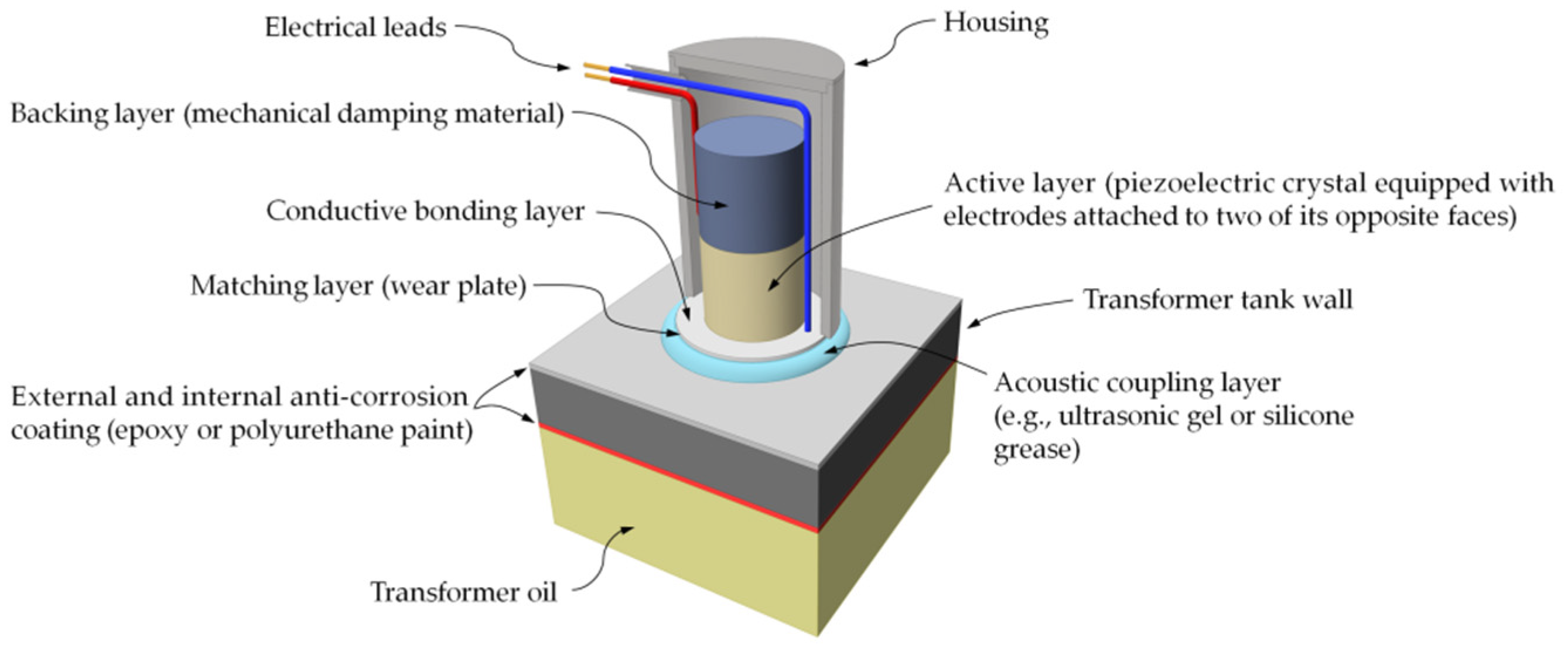
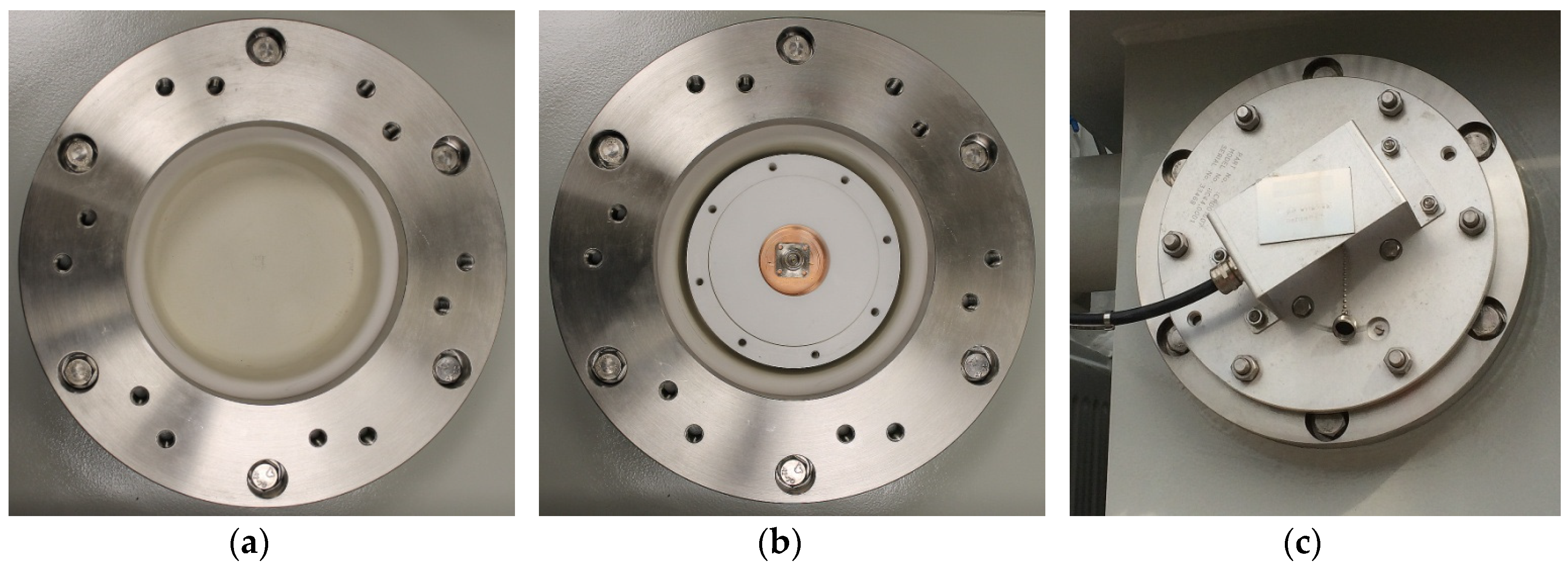

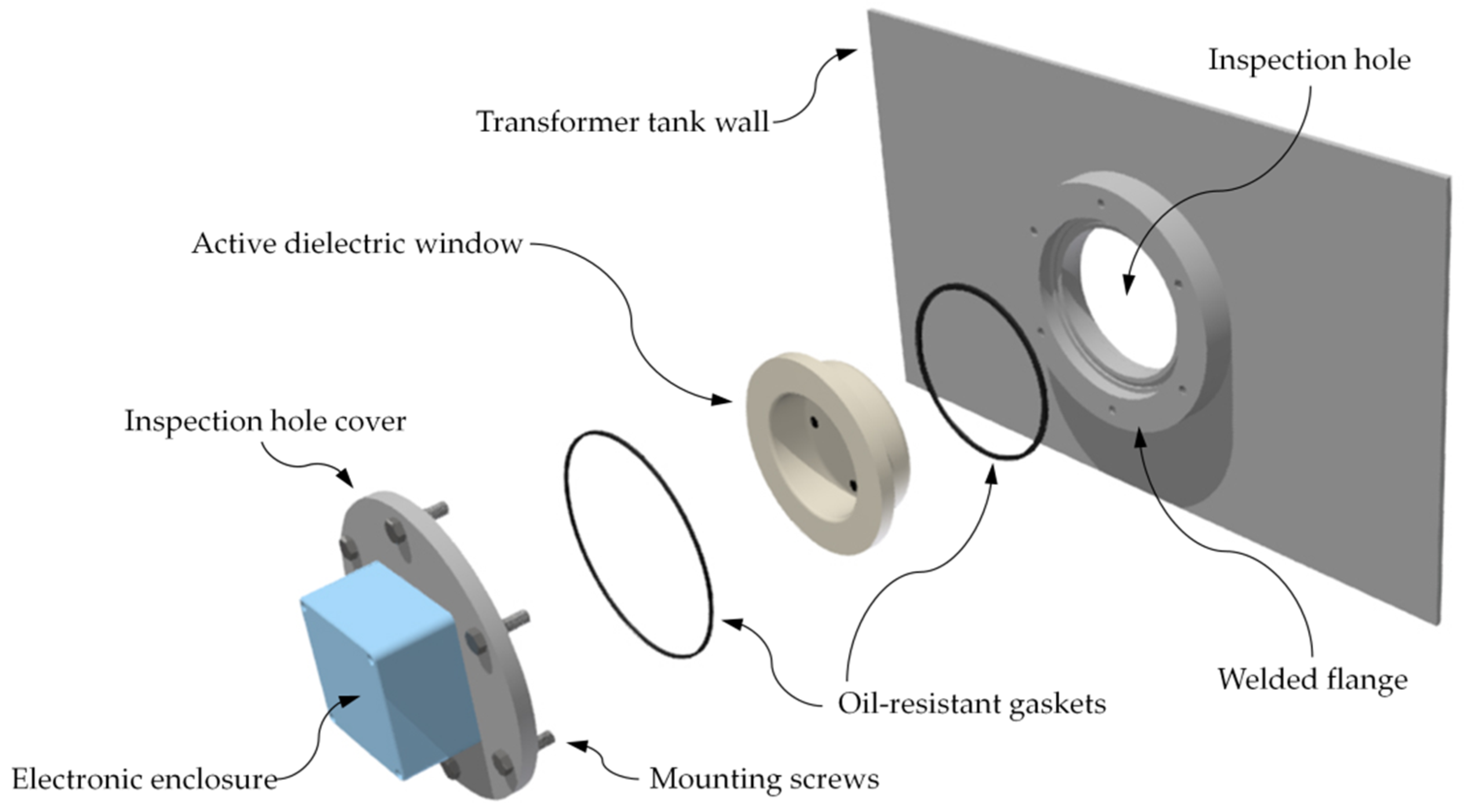
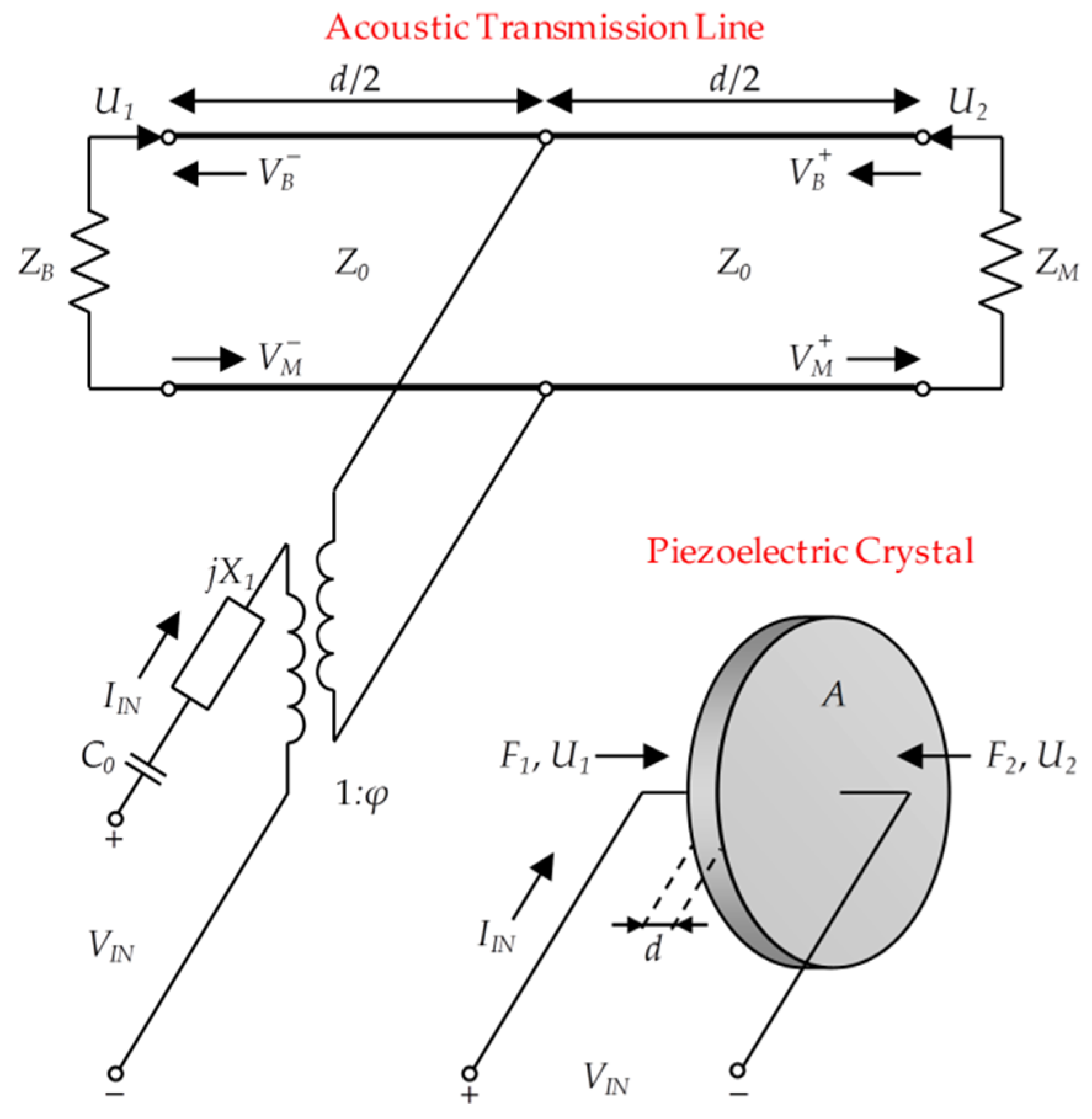
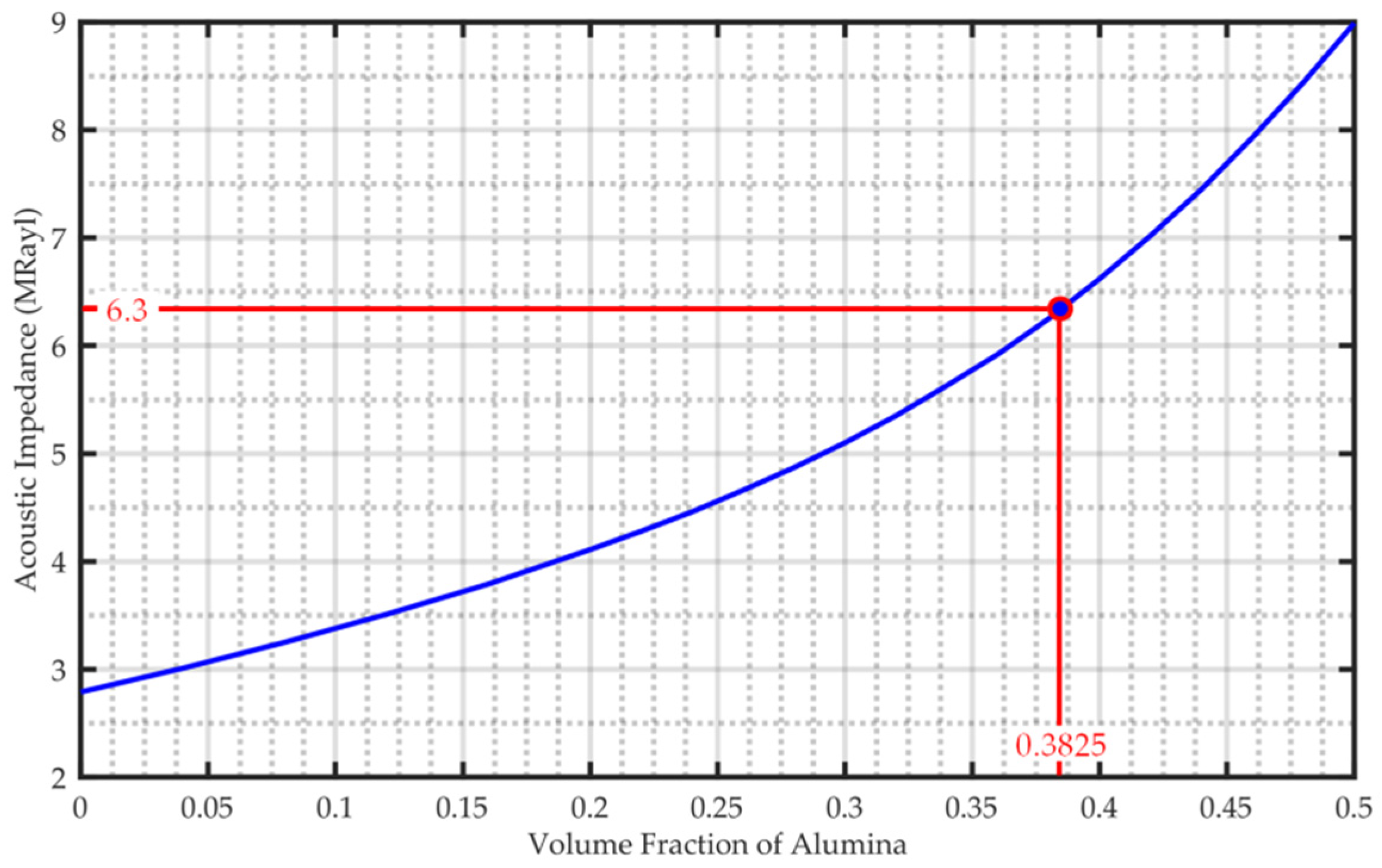

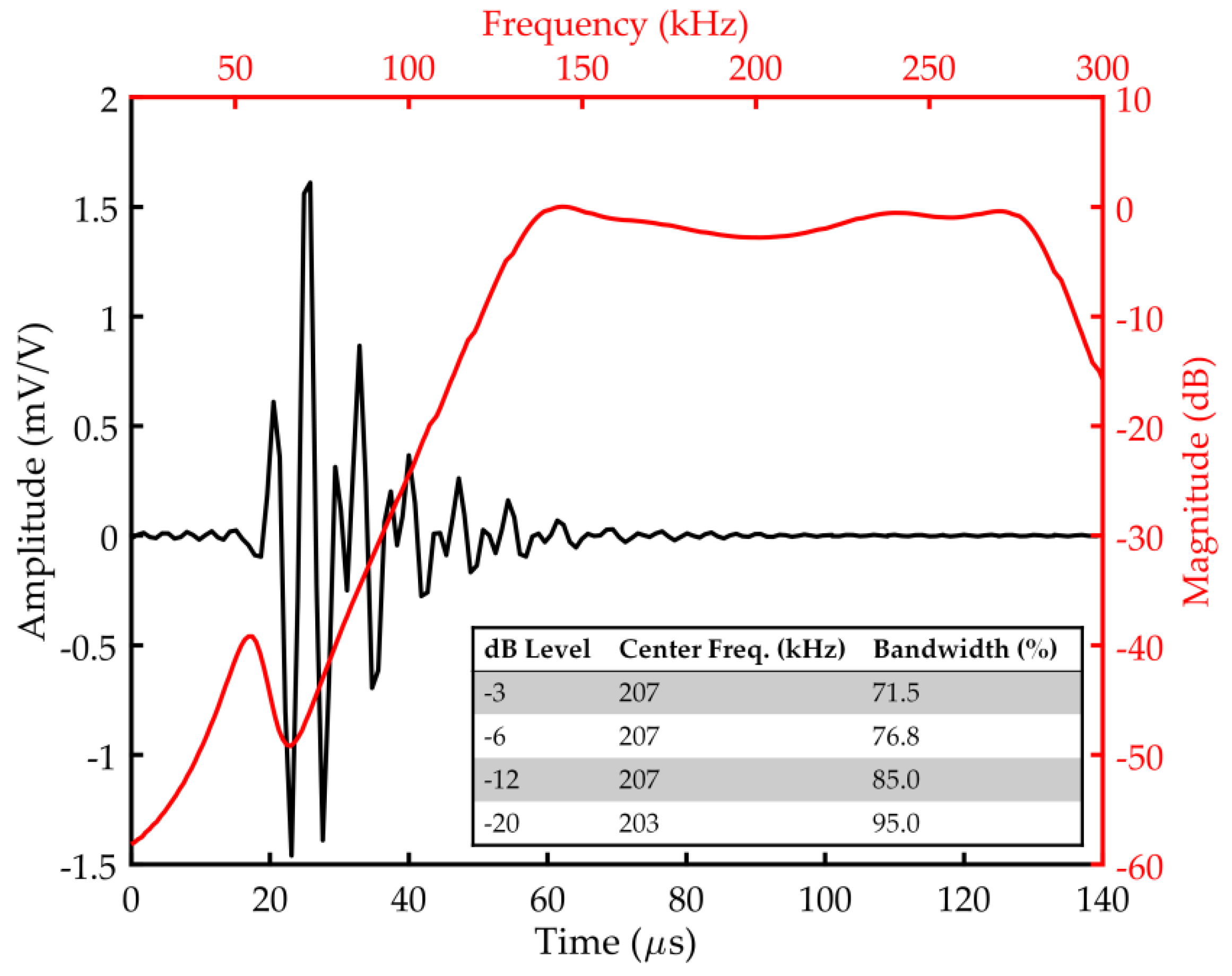
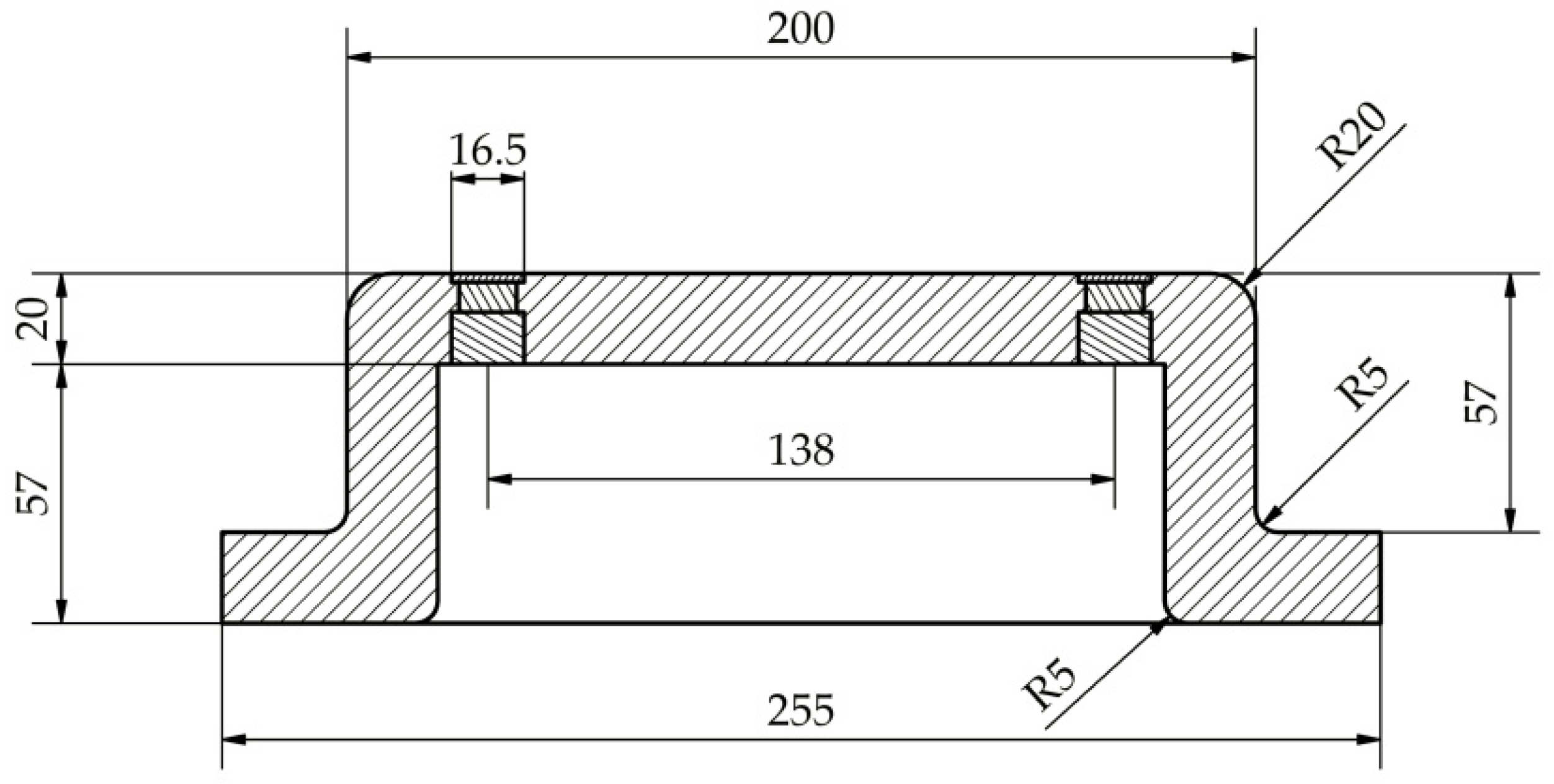

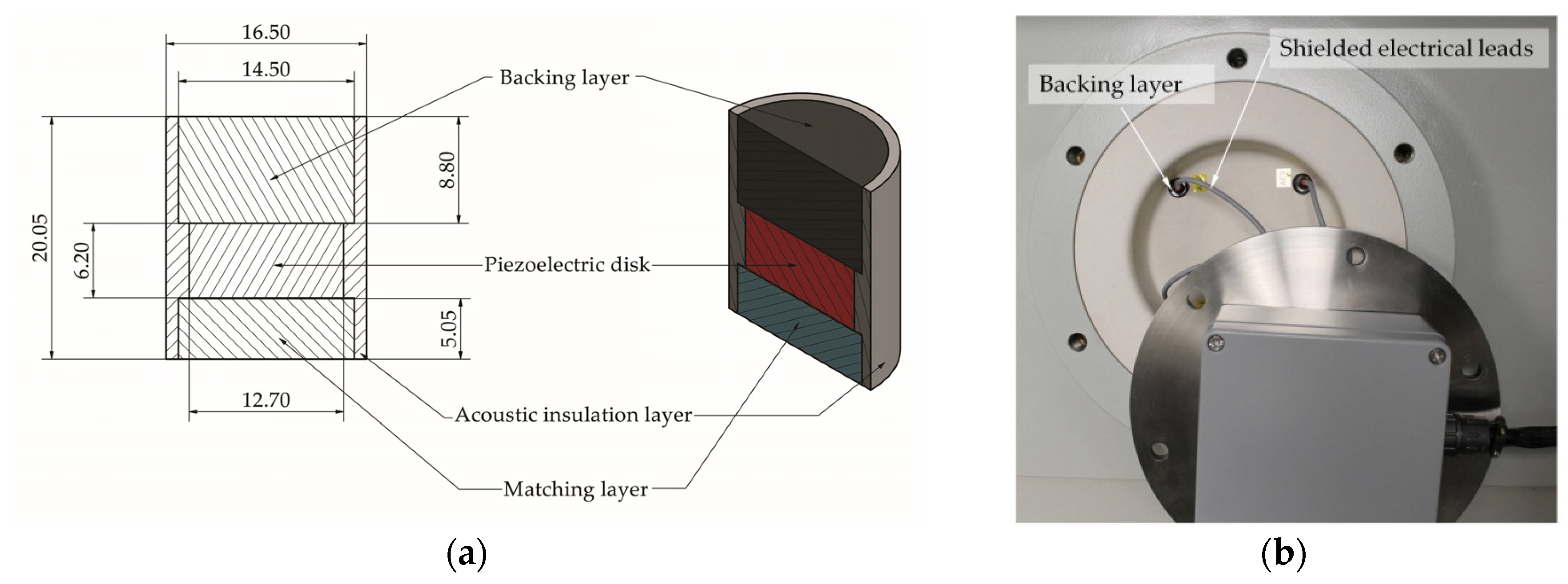
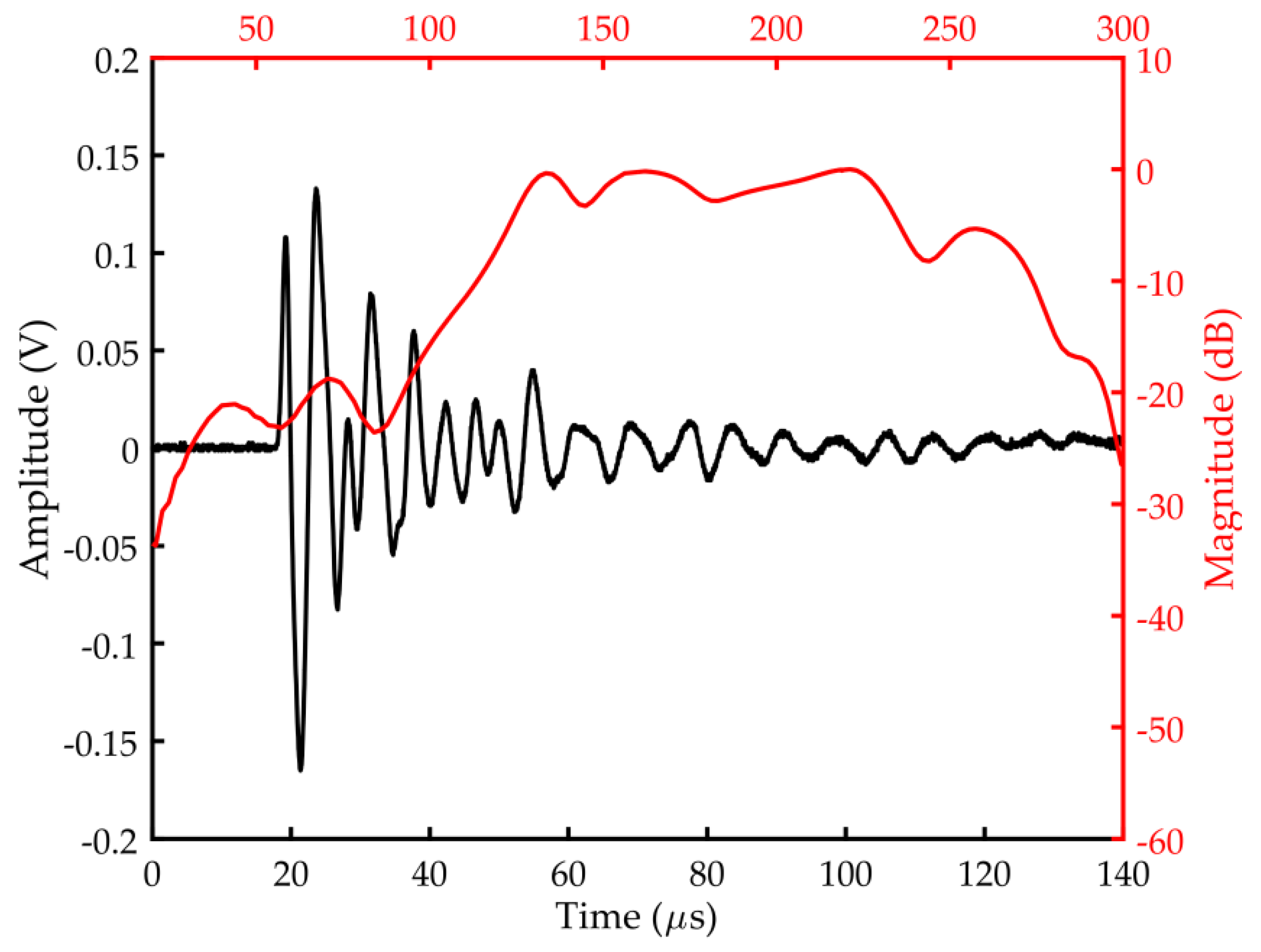
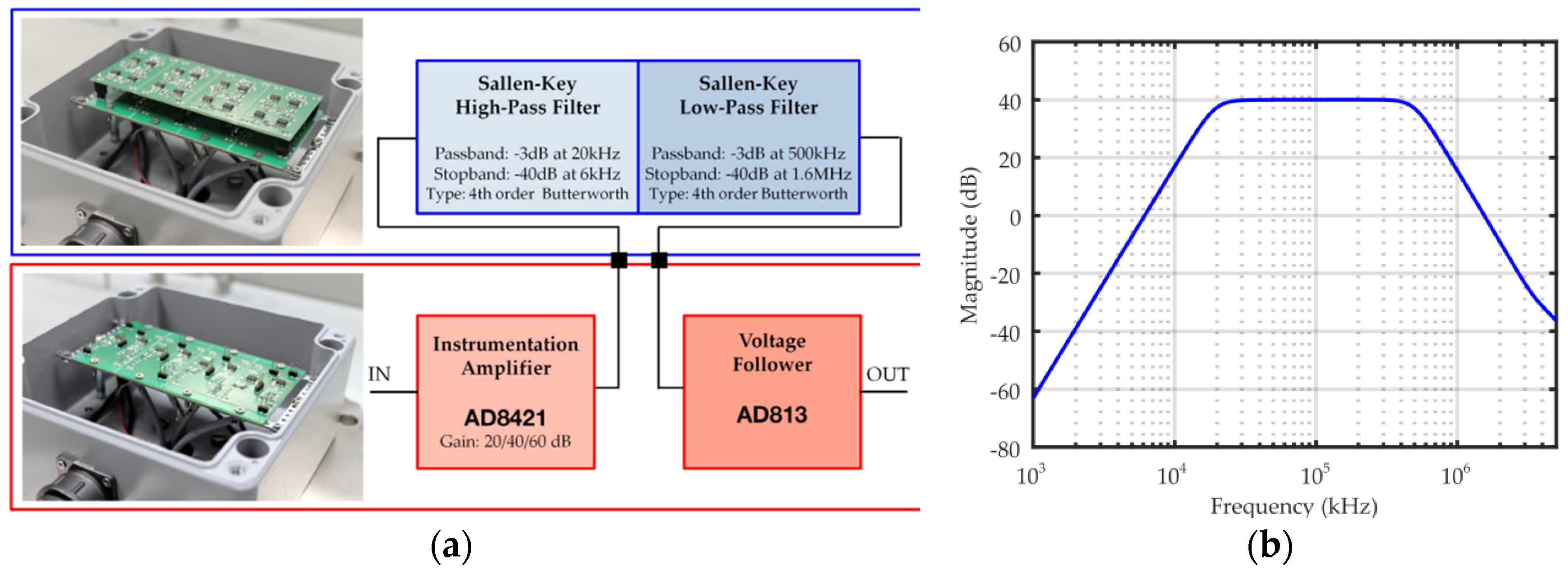
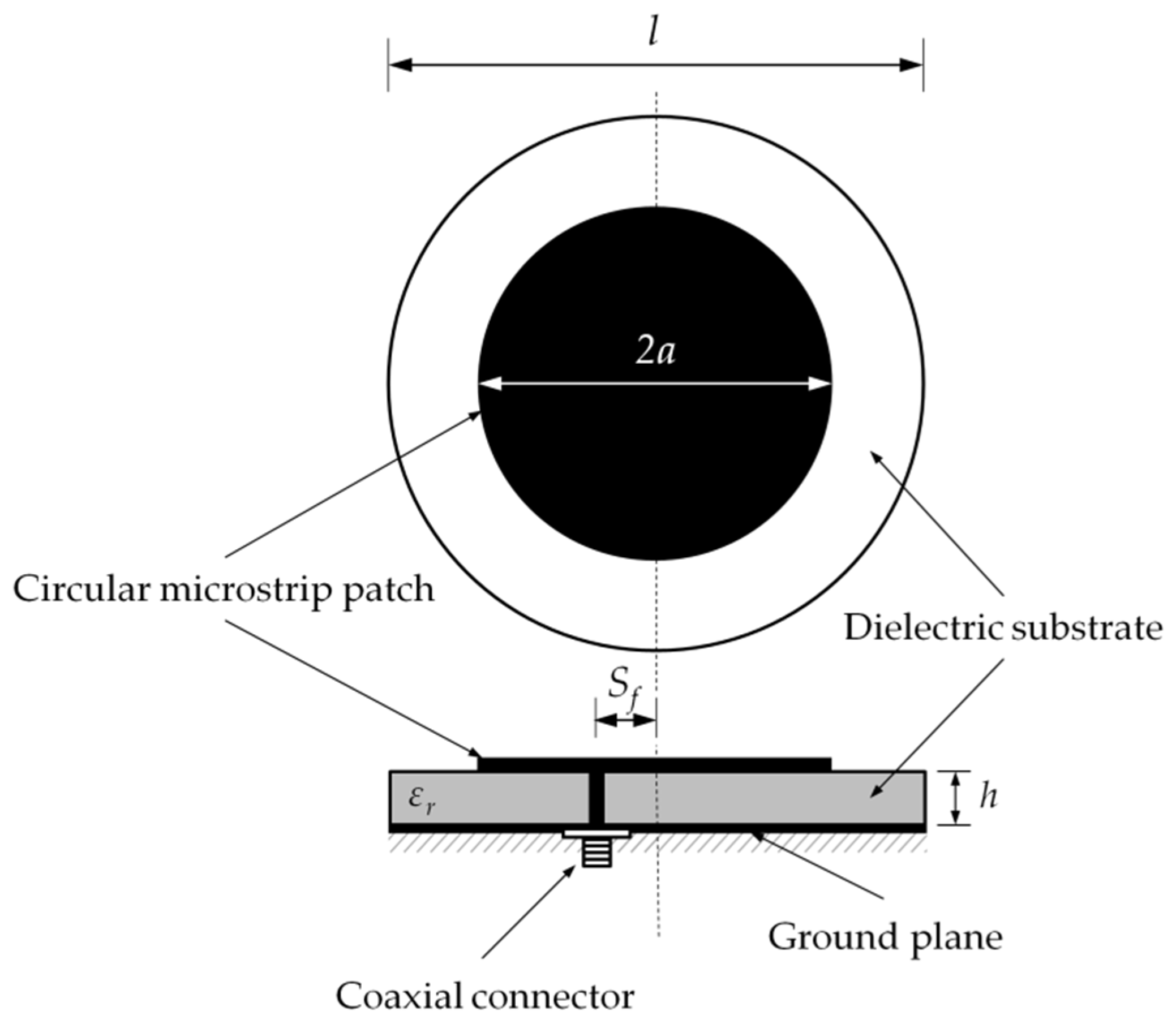


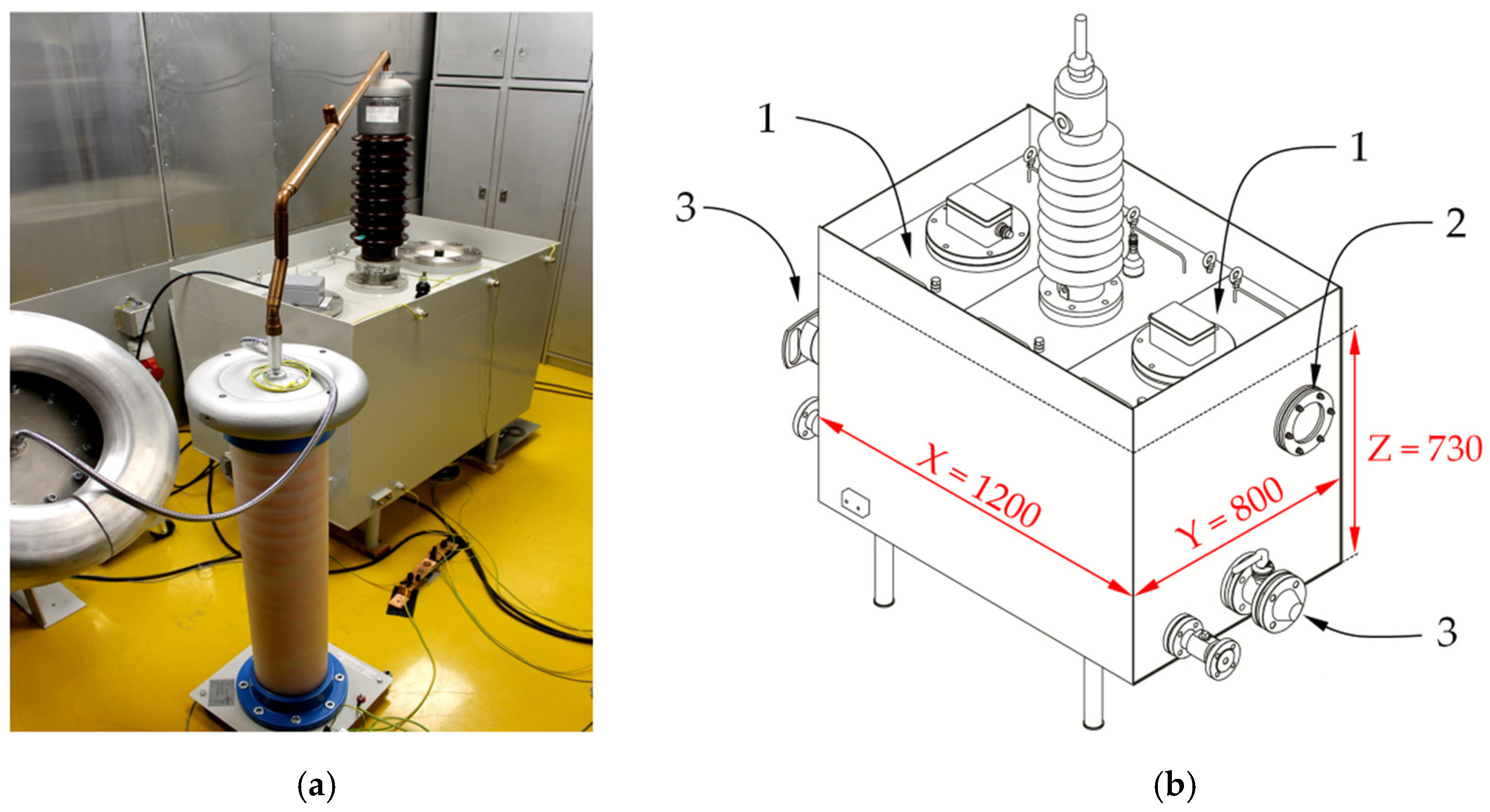
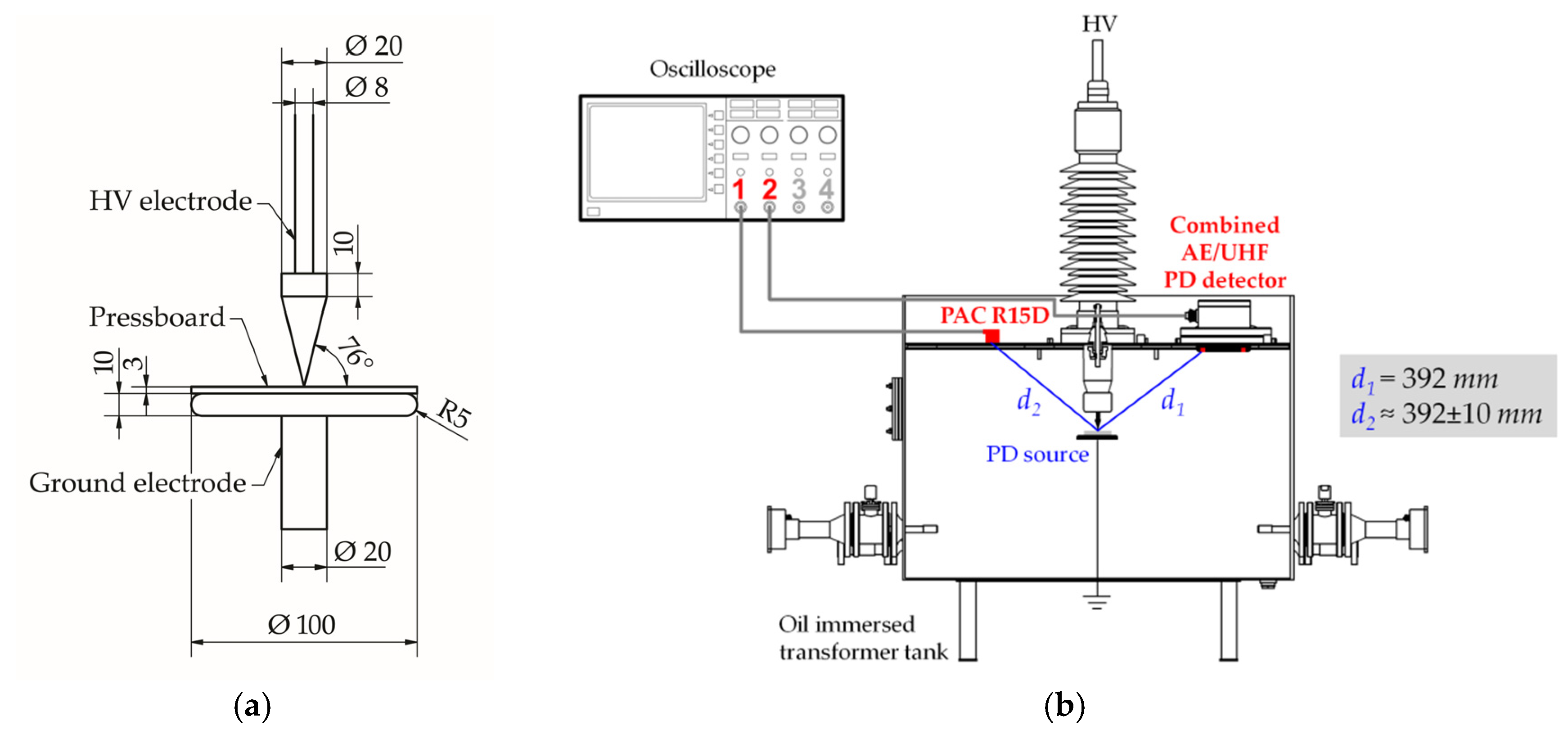
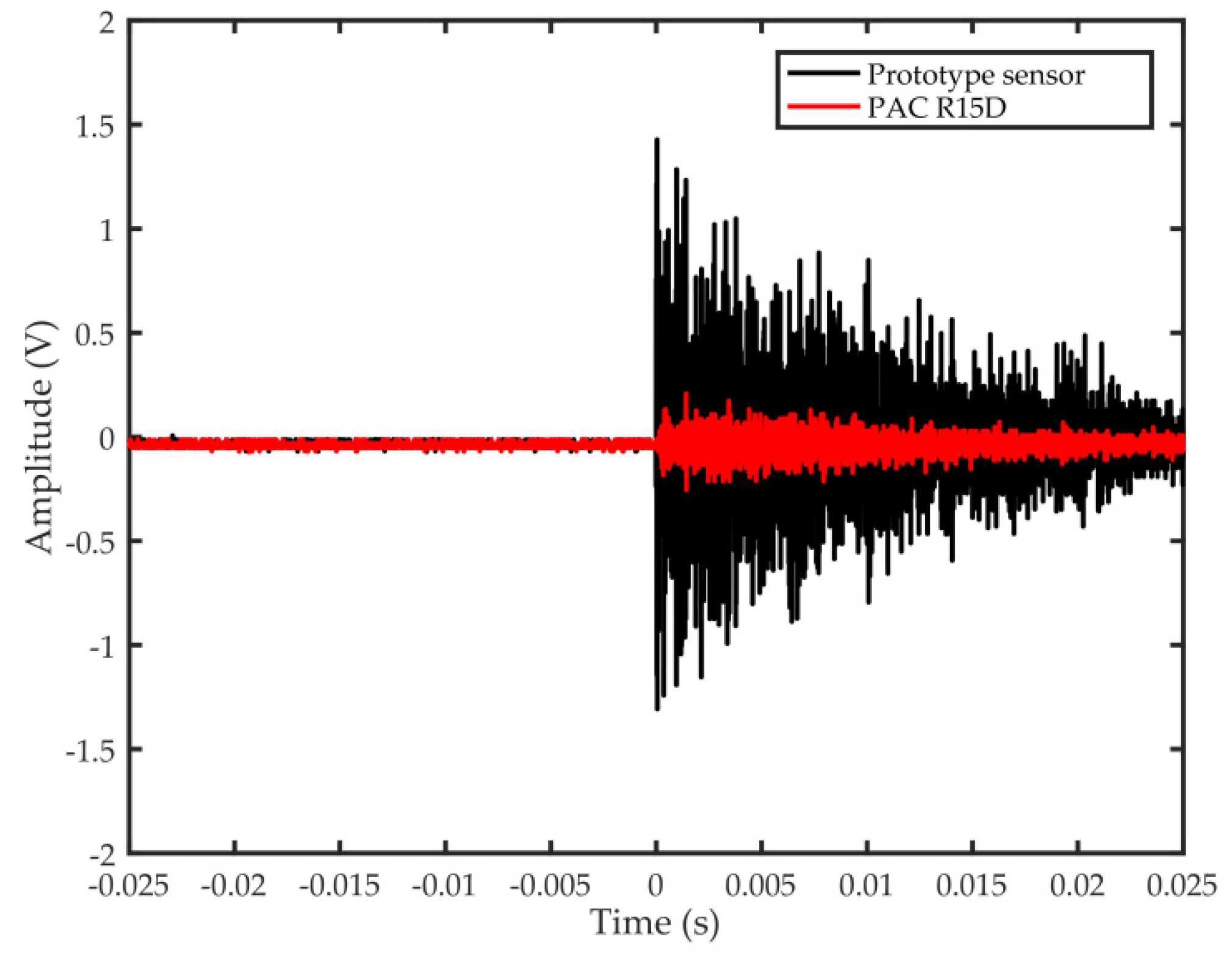
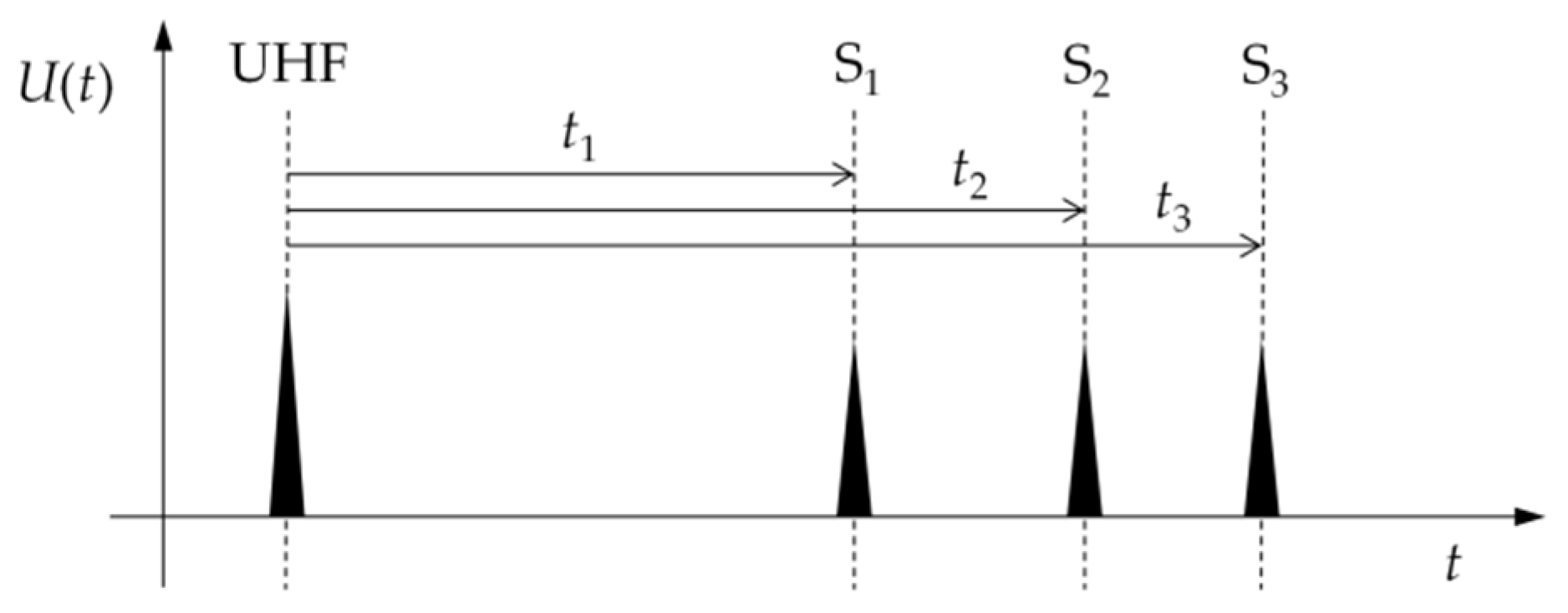
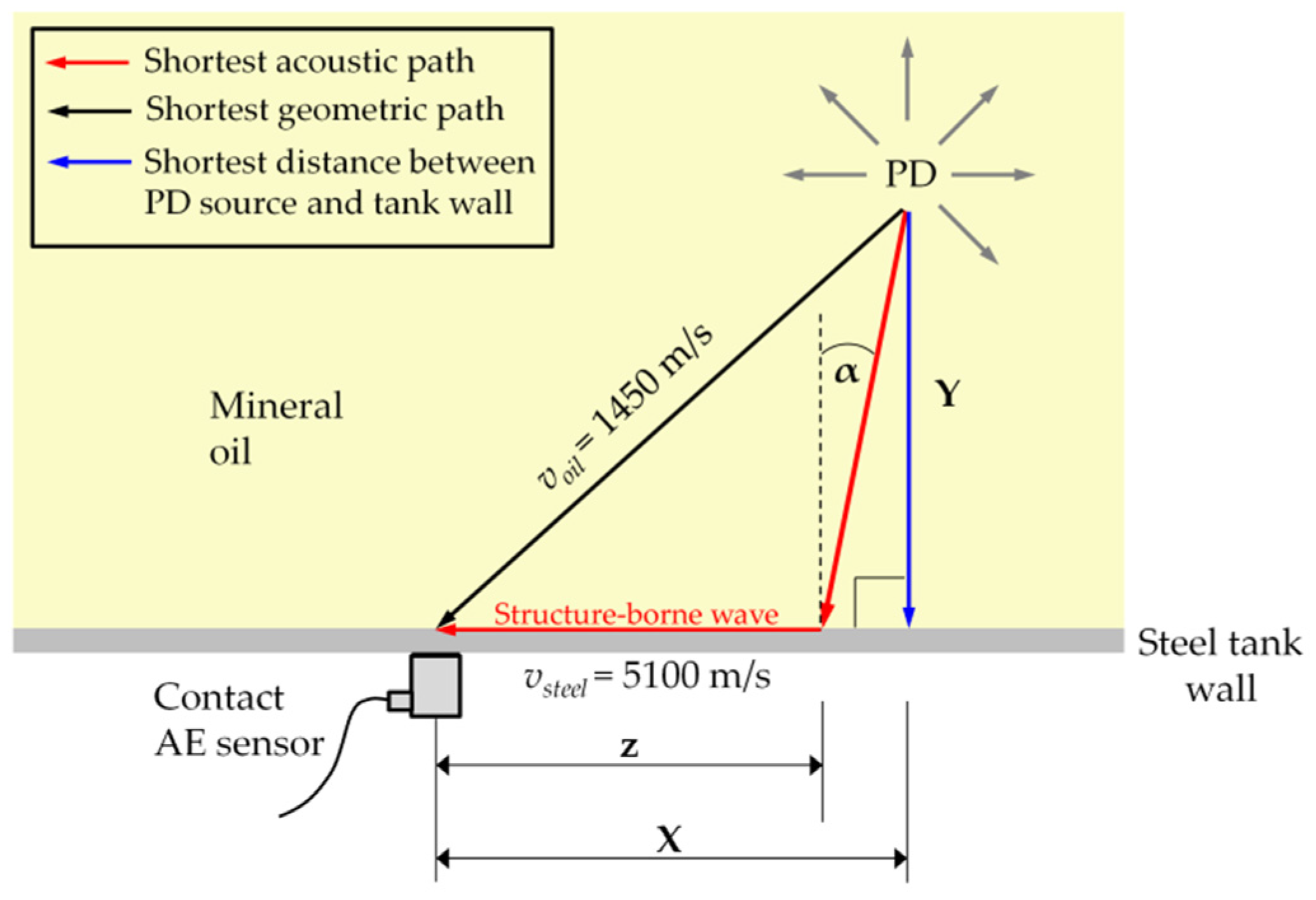
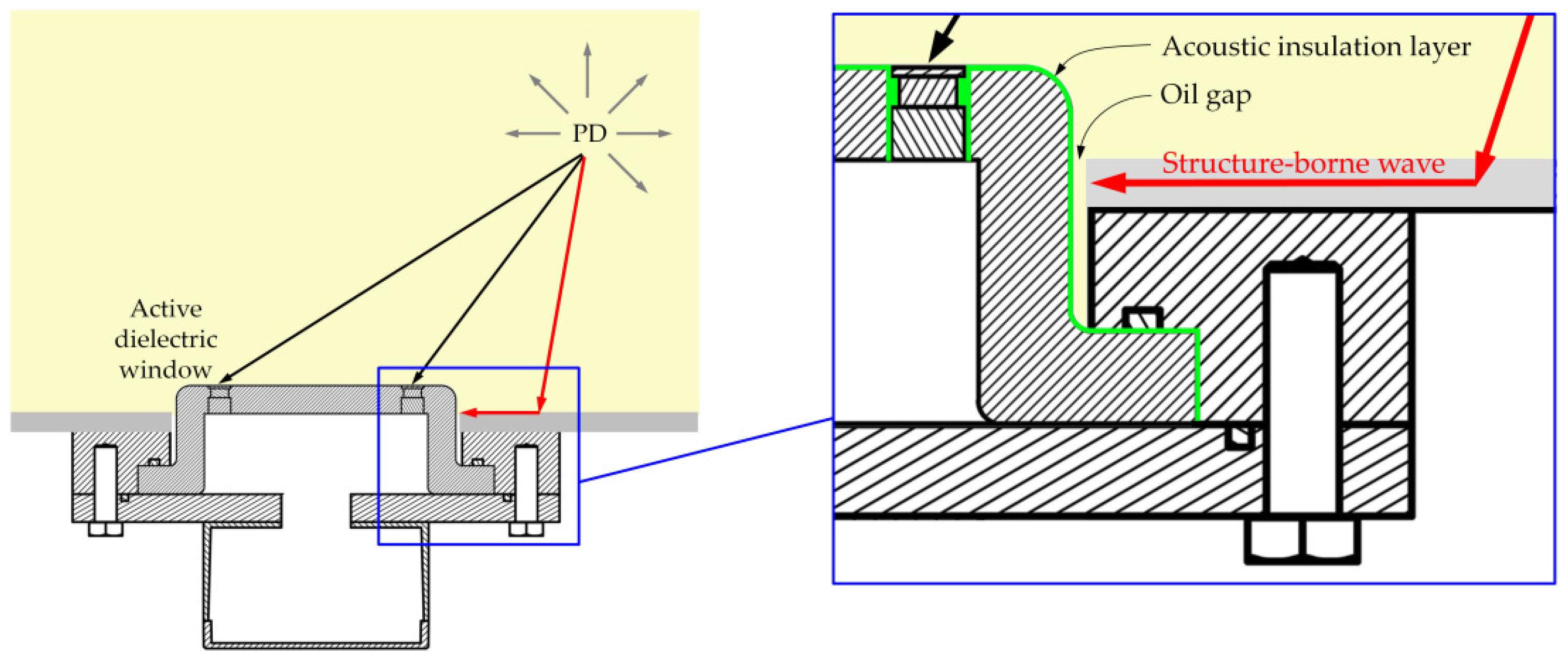
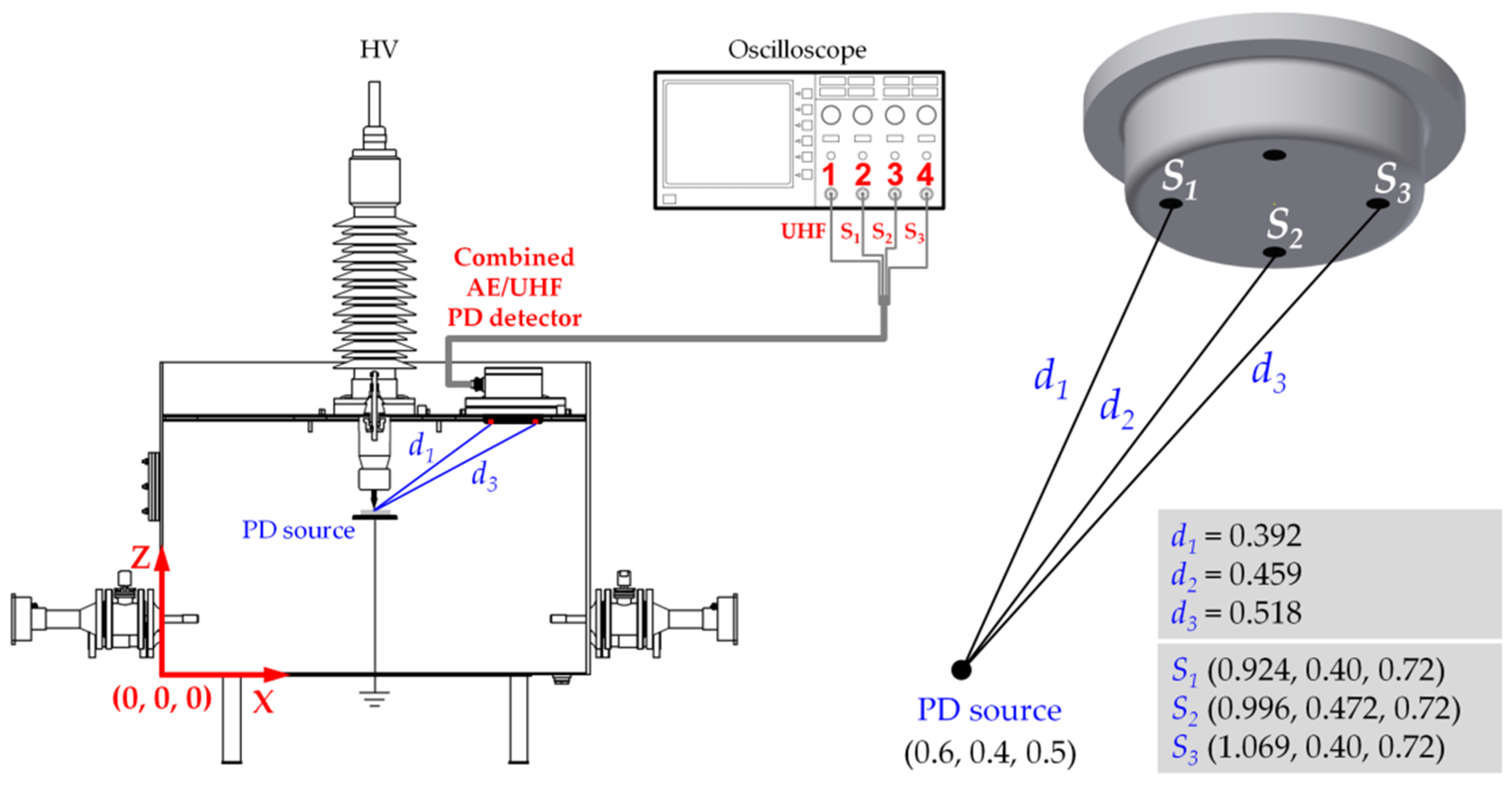
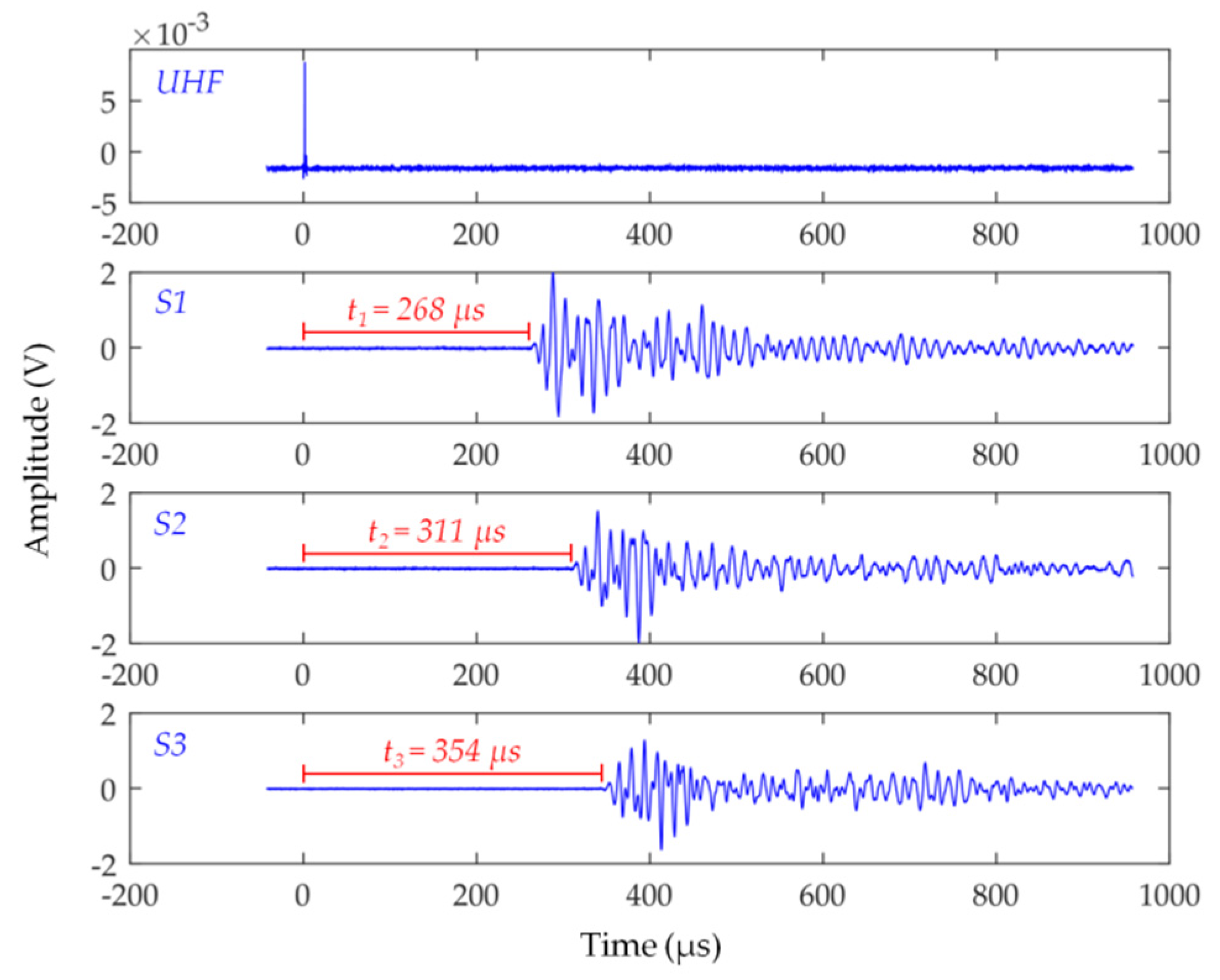
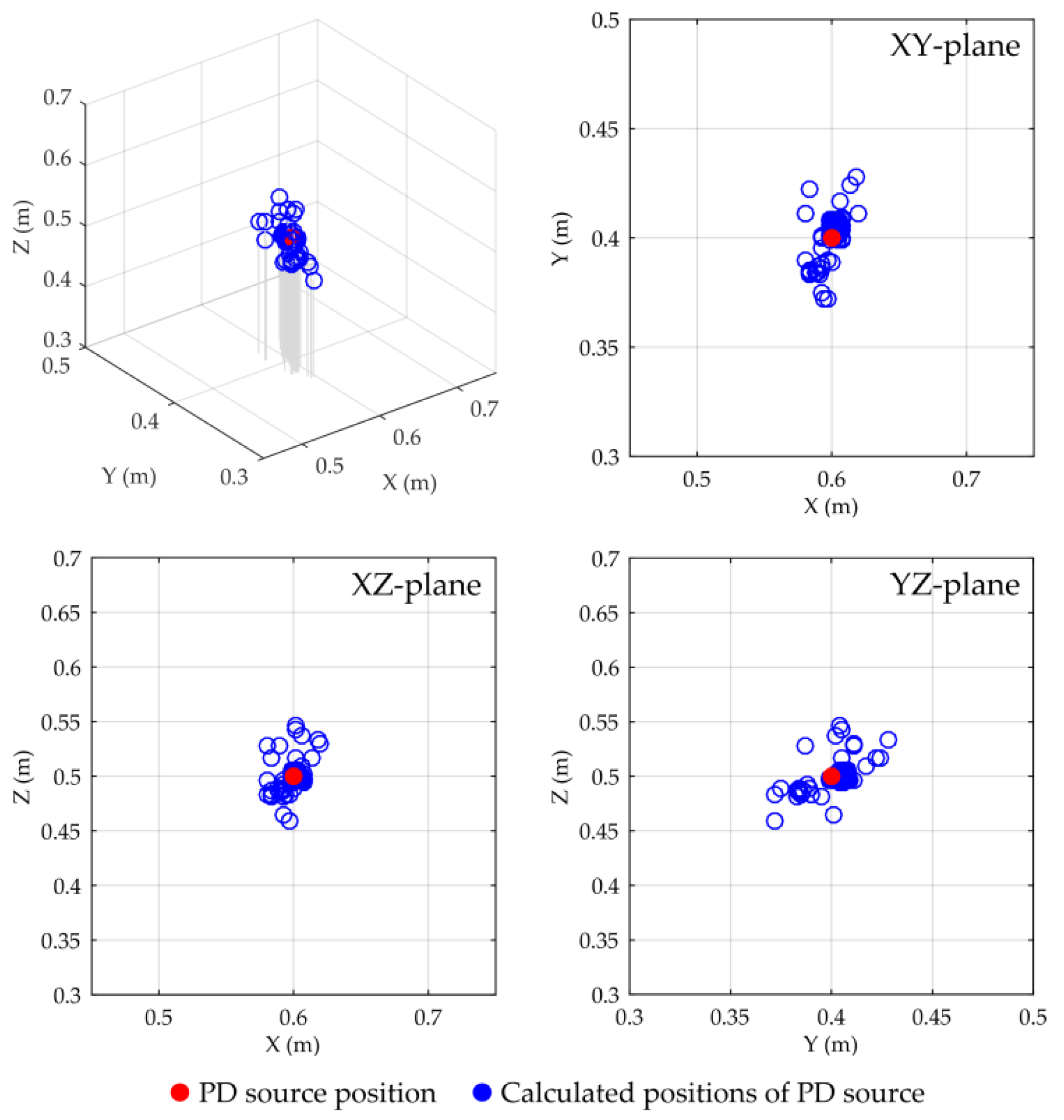

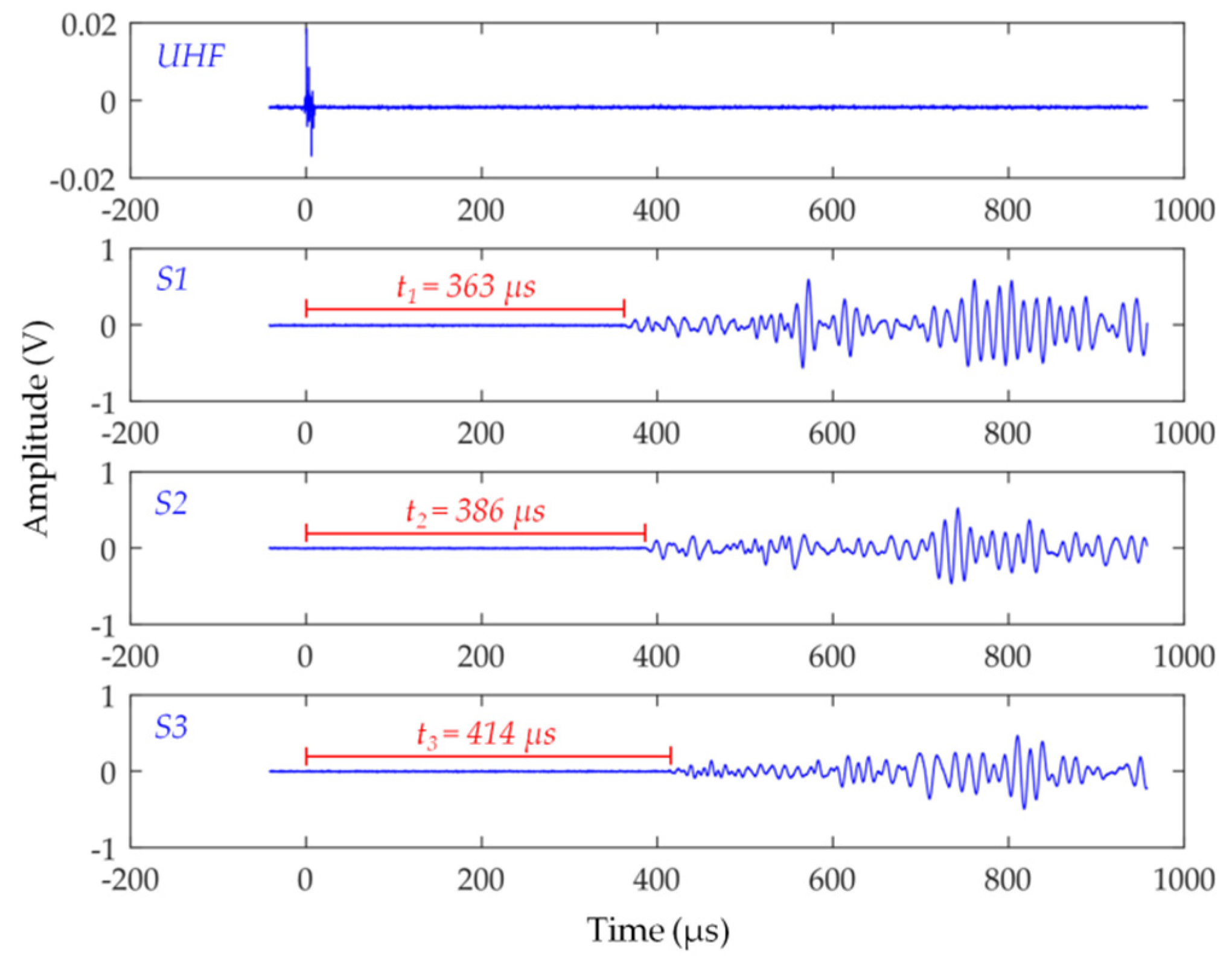
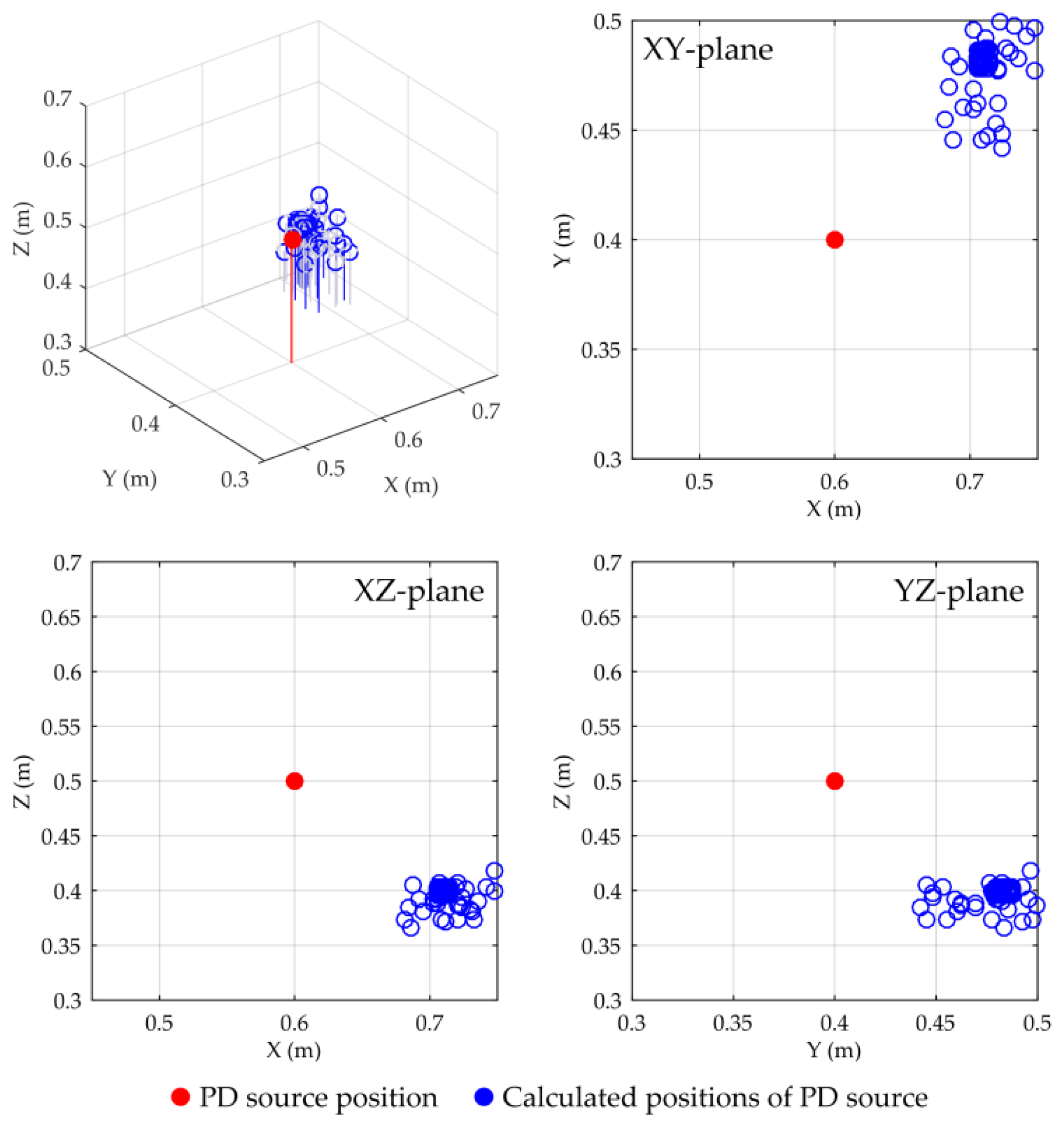
| Parameter | Material | Symbol | Unit | ||
|---|---|---|---|---|---|
| Epoxy | Alumina Powder | Tungsten Powder | |||
| Density | 1094 a | 3670 | 19250 | ρ | kg/m3 |
| Bulk modulus | 5.1 | 165 | 310 | K | GPa |
| Shear modulus | 1.5 | 124 | 161 | G | GPa |
| Longitudinal velocity | 2550 | 9487 | 5221 | VL | m/s |
| Shear velocity | 1174 | 5813 | 2892 | VS | m/s |
| Acoustic impedance | 2.79 | 34.8 | 100.5 | Z | MRayl |
| Particle size | N/A | 1 | 0.6‒1 | D | μm |
| Purity | N/A | ≥99.9 | ≥99.9 b | ‒ | % |
| Parameter | Symbol | Value | Unit | |
|---|---|---|---|---|
| Relative dielectric constant | KT | 1900 | ‒ | |
| Electromechanical coupling coefficients: | ||||
| Longitudinal coupling coefficient | k33 | 0.72 | ‒ | |
| Transverse coupling coefficient | k31 | 0.36 | ‒ | |
| Shear coupling coefficient | k15 | 0.68 | ‒ | |
| Planar coupling coefficient | kp | 0.63 | ‒ | |
| Thickness coupling factor | kt | 0.49 | ‒ | |
| Piezoelectric charge constants: | ||||
| Induced strain in direction 3 per unit electric field | 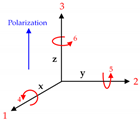 | d33 | 400 | m/V3 |
| Induced strain in direction 1 per unit electric field applied in direction 3 | d31 | 175 | m/V3 | |
| Induced shear strain about direction 2 per unit electric field applied in direction 1 | d15 | 590 | m/V3 | |
| Dielectric dissipation factor (dielectric loss) 1 | tan σ | ≤2.00 | % | |
| Frequency constants: | ||||
| Frequency constant for thickness vibration mode | NT | 2040 | Hz·m | |
| Frequency constant for planar vibration mode | NP | 1980 | Hz·m | |
| Frequency constant for longitudinal vibration mode | NL | 1500 | Hz·m | |
| Curie point 2 | TC | 360 | °C | |
| Density | ρ | 7600 | kg/m3 | |
| Parameter | Symbol | Value | Unit |
|---|---|---|---|
| Active layer (piezoelectric ceramic): | |||
| Thickness | d | 6.2 | Mm |
| Radius | r | 6.35 | Mm |
| Area | A | 126.61 | mm2 |
| Acoustic impedance | Z0 | 31.0 | MRayl |
| Backing layer 1: | |||
| Thickness | d | 8.8 | Mm |
| Density | ρ | 2546 | kg/m3 |
| Longitudinal velocity | VL | 1790 | m/s |
| Shear velocity | VS | 845 | m/s |
| Acoustic impedance | ZB | 4.56 | MRayl |
| Bulk modulus | K | 5.74 | GPa |
| Shear modulus | G | 1.82 | GPa |
| Matching layer 2: | |||
| Thickness | d | 5.05 | Mm |
| Density | ρ | 2079 | kg/m3 |
| Longitudinal velocity | VL | 3029 | m/s |
| Shear velocity | VS | 1640 | m/s |
| Bulk modulus | K | 11.62 | GPa |
| Shear modulus | G | 5.59 | GPa |
| Acoustic impedance | ZM | 6.3 | MRayl |
| Parameter | Symbol | Value | Unit |
|---|---|---|---|
| Apparent (bulk) density 1 | ρb | 2500 | kg/m3 |
| Flexural strength 1 | σ | 140 | MPa |
| Fracture toughness 1 | K | 2.0 | MPa·m1/2 |
| Young’s modulus 1 | E | 100 | GPa |
| Abrasion resistance (volume loss) | WV | 172 | mm3 |
| Dielectric strength 1 | VB | 20 | kV/mm |
| Resistivity 1 | ρ | 1013 | Ω·cm |
| Thermal shock resistance 1 | Tc | 150 | K |
| Parameter | Symbol | Value | Unit |
|---|---|---|---|
| Elongation at break at 23 °C 1 | εB | 900 | % |
| Tensile strength at break at 23 °C 1 | σB | 13 | MPa |
| Tear resistance at 23 °C 2 | TS | 54 | kN/m |
| Abrasion resistance 3 | AR | 18 | mg/100u |
| Hardness, Shore A 4 | HSA | 85 | - |
| Working temperature | TW | −40/+90 | °C |
| Coordinates | Location of PD Source and Error | |||||
|---|---|---|---|---|---|---|
| Actual Location (m) | Calculated Location 1 (m) | Mean Location Error | Maximum Location Error | |||
| (cm) | (%) | (cm) | (%) | |||
| X | 0.600 | 0.596 | −0.4 | 0.7 | 2.0 | 3.3 |
| Y | 0.400 | 0.407 | 0.7 | 1.8 | 2.8 | 7.0 |
| Z | 0.500 | 0.485 | −1.5 | 3.0 | 4.6 | 9.2 |
| Coordinates | Location of PD Source and Error | |||||
|---|---|---|---|---|---|---|
| Actual Location (m) | Calculated Location 1 (m) | Mean Location Error | Maximum Location Error | |||
| (cm) | (%) | (cm) | (%) | |||
| X | 0.600 | 0.710 | 11.0 | 18.3 | 14.8 | 24.7 |
| Y | 0.400 | 0.479 | 7.9 | 19.8 | 10.7 | 26.8 |
| Z | 0.500 | 0.396 | −10.4 | 20.8 | 13.5 | 27.0 |
© 2018 by the author. Licensee MDPI, Basel, Switzerland. This article is an open access article distributed under the terms and conditions of the Creative Commons Attribution (CC BY) license (http://creativecommons.org/licenses/by/4.0/).
Share and Cite
Sikorski, W. Active Dielectric Window: A New Concept of Combined Acoustic Emission and Electromagnetic Partial Discharge Detector for Power Transformers. Energies 2019, 12, 115. https://doi.org/10.3390/en12010115
Sikorski W. Active Dielectric Window: A New Concept of Combined Acoustic Emission and Electromagnetic Partial Discharge Detector for Power Transformers. Energies. 2019; 12(1):115. https://doi.org/10.3390/en12010115
Chicago/Turabian StyleSikorski, Wojciech. 2019. "Active Dielectric Window: A New Concept of Combined Acoustic Emission and Electromagnetic Partial Discharge Detector for Power Transformers" Energies 12, no. 1: 115. https://doi.org/10.3390/en12010115
APA StyleSikorski, W. (2019). Active Dielectric Window: A New Concept of Combined Acoustic Emission and Electromagnetic Partial Discharge Detector for Power Transformers. Energies, 12(1), 115. https://doi.org/10.3390/en12010115





